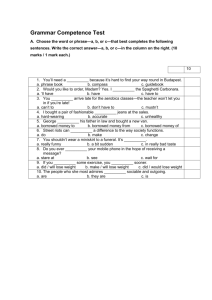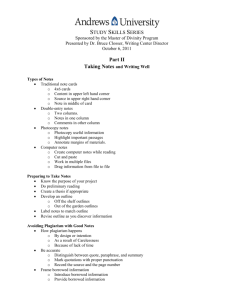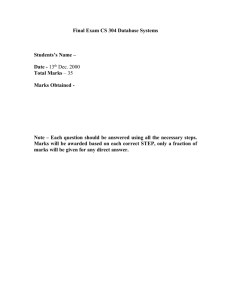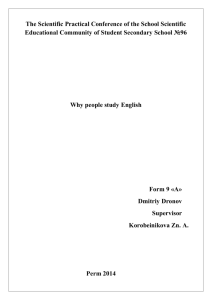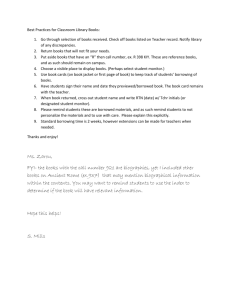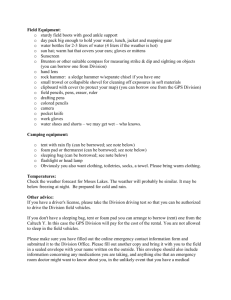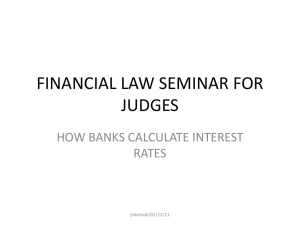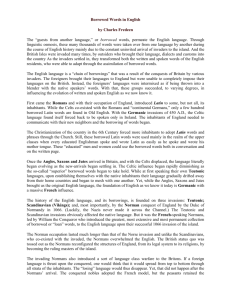to OPEN IT-533 PDF
advertisement
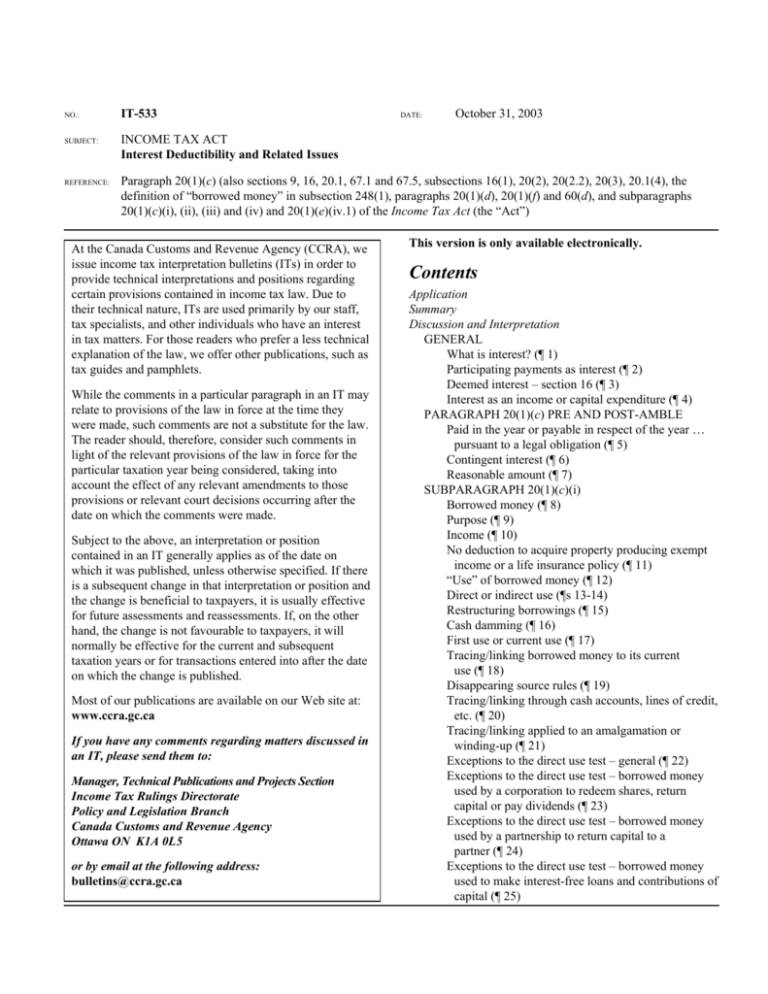
NO.: SUBJECT: REFERENCE: IT-533 DATE: October 31, 2003 INCOME TAX ACT Interest Deductibility and Related Issues Paragraph 20(1)(c) (also sections 9, 16, 20.1, 67.1 and 67.5, subsections 16(1), 20(2), 20(2.2), 20(3), 20.1(4), the definition of “borrowed money” in subsection 248(1), paragraphs 20(1)(d), 20(1)(f) and 60(d), and subparagraphs 20(1)(c)(i), (ii), (iii) and (iv) and 20(1)(e)(iv.1) of the Income Tax Act (the “Act”) At the Canada Customs and Revenue Agency (CCRA), we issue income tax interpretation bulletins (ITs) in order to provide technical interpretations and positions regarding certain provisions contained in income tax law. Due to their technical nature, ITs are used primarily by our staff, tax specialists, and other individuals who have an interest in tax matters. For those readers who prefer a less technical explanation of the law, we offer other publications, such as tax guides and pamphlets. While the comments in a particular paragraph in an IT may relate to provisions of the law in force at the time they were made, such comments are not a substitute for the law. The reader should, therefore, consider such comments in light of the relevant provisions of the law in force for the particular taxation year being considered, taking into account the effect of any relevant amendments to those provisions or relevant court decisions occurring after the date on which the comments were made. Subject to the above, an interpretation or position contained in an IT generally applies as of the date on which it was published, unless otherwise specified. If there is a subsequent change in that interpretation or position and the change is beneficial to taxpayers, it is usually effective for future assessments and reassessments. If, on the other hand, the change is not favourable to taxpayers, it will normally be effective for the current and subsequent taxation years or for transactions entered into after the date on which the change is published. Most of our publications are available on our Web site at: www.ccra.gc.ca If you have any comments regarding matters discussed in an IT, please send them to: Manager, Technical Publications and Projects Section Income Tax Rulings Directorate Policy and Legislation Branch Canada Customs and Revenue Agency Ottawa ON K1A 0L5 or by email at the following address: bulletins@ccra.gc.ca This version is only available electronically. Contents Application Summary Discussion and Interpretation GENERAL What is interest? (¶ 1) Participating payments as interest (¶ 2) Deemed interest – section 16 (¶ 3) Interest as an income or capital expenditure (¶ 4) PARAGRAPH 20(1)(c) PRE AND POST-AMBLE Paid in the year or payable in respect of the year … pursuant to a legal obligation (¶ 5) Contingent interest (¶ 6) Reasonable amount (¶ 7) SUBPARAGRAPH 20(1)(c)(i) Borrowed money (¶ 8) Purpose (¶ 9) Income (¶ 10) No deduction to acquire property producing exempt income or a life insurance policy (¶ 11) “Use” of borrowed money (¶ 12) Direct or indirect use (¶s 13-14) Restructuring borrowings (¶ 15) Cash damming (¶ 16) First use or current use (¶ 17) Tracing/linking borrowed money to its current use (¶ 18) Disappearing source rules (¶ 19) Tracing/linking through cash accounts, lines of credit, etc. (¶ 20) Tracing/linking applied to an amalgamation or winding-up (¶ 21) Exceptions to the direct use test – general (¶ 22) Exceptions to the direct use test – borrowed money used by a corporation to redeem shares, return capital or pay dividends (¶ 23) Exceptions to the direct use test – borrowed money used by a partnership to return capital to a partner (¶ 24) Exceptions to the direct use test – borrowed money used to make interest-free loans and contributions of capital (¶ 25) IT-533 This bulletin does not take into account proposed amendments to the law – see Appendix B. Unless otherwise stated, all statutory references throughout the bulletin are to the Act. Exceptions to the direct use test – borrowed money used to make interest-free loans to employees and shareholders (¶ 26) SUBPARAGRAPH 20(1)(c)(ii) Amount payable for property acquired (¶ 27) Purpose of gaining or producing income (¶ 28) Note issued to redeem shares (¶ 29) SUBPARAGRAPHS 20(1)(c)(iii) & (iv) Interest on an amount paid under an appropriation Act or on borrowed money to acquire an interest in an annuity contract (¶ 30) OTHER INTEREST DEDUCTIBILITY AND RELATED ISSUES Borrowing for investments including common shares (¶ 31) Loss utilizations within an affiliated group (¶ 32) Borrowed money used to honour guarantees (¶ 33) Borrowing to make non-deductible expenditures (¶ 34) Security provided for borrowed money or an amount payable (¶ 35) Interest on amounts payable where no property acquired (¶ 36) Discounts arising on the issuance of debt obligations (¶ 37) Premiums arising on the issuance of debt obligations (¶ 38) Interest on credit card transactions (¶ 39) Interest on death duties (40) Refinancing transactions (¶ 41) Other provisions of the Act regarding interest deductibility (¶ 42) Appendix A – References to court cases referred to in the bulletin Appendix B – Draft proposals: Deductibility of interest and other expenses Summary This bulletin discusses the CCRA’s interpretations of the deductibility of interest expense under various provisions of the Act and the judgments in numerous court decisions involving the deductibility of interest expense. An amount is considered to be interest if it represents compensation for the use of money, if it is referable to a principal sum and if it accrues day-to-day. Generally, interest expense is considered to be a capital expenditure. Accordingly, specific provisions of the Act must be met in order for interest to be deductible. The specific provisions of the Act include the requirement that an amount be paid in the year or payable in respect of the year, that the amount be paid pursuant to a legal obligation and that the amount be reasonable. Where money is borrowed, the use of the money must be established and the purpose of that use must be for earning income (other than exempt income or to acquire an interest in certain life insurance policies). In this context, use is the current use of the borrowed money and in certain situations may include indirect use. Where an amount is payable for property acquired, the property must be acquired for the purpose of earning income (other than exempt income or to acquire an interest in certain life insurance policies). In certain borrowing transactions, a debt may be issued at a premium or discount. The tax treatment of these amounts is also discussed in the bulletin. Other matters related to interest deductibility are also discussed in the bulletin. However, other tax consequences from transactions involving interest deductibility are not discussed in the bulletin. Application This new bulletin discusses interest deductibility and other related matters and replaces and cancels: • IT-80, Interest on Money Borrowed to Redeem Shares, or to Pay Dividends; • IT-203, Interest on Death Duties; • IT-315, Interest Expense Incurred for the Purpose of Winding-up or Amalgamation; • IT-445, The Deduction of Interest on Funds Borrowed either to be Loaned at less than a Reasonable Rate of Interest or to Honour a Guarantee Given for Inadequate Consideration in Non-arm’s Length Circumstances; and • IT-498, The Deductibility of Interest on Money Borrowed to Reloan to Employees or Shareholders. Appendix A includes the citations for all court cases referred to in this bulletin. Discussion and Interpretation GENERAL What is interest? ¶ 1. “Interest” is not defined in the Act but has been addressed in several court decisions, including Shell, Sherway Centre and Miller. As in Miller, interest for tax purposes is generally accepted to mean an amount that has met three criteria. These criteria are that the amount must be calculated on a day-to-day accrual basis, the amount must be calculated on a principal sum (or a right to a principal sum), and the amount must be compensation for the use of the principal sum (or the right to the principal sum). In addition, previous Canada Customs and Revenue Agency (CCRA) positions on this subject expressed in other fora may generally no longer be relied upon as the CCRA’s current positions on interest deductibility. 2 IT-533 Participating payments as interest basis pursuant to paragraph 20(1)(d). In addition, the preamble requires that all amounts must be paid or payable pursuant to a legal obligation to pay interest. ¶ 2. Consistent with Sherway Centre, participating payments for amounts that are interest are deductible under paragraph 20(1)(c) where: • the payment is limited to a stated percentage of the principal (or the facts show that the payments are intended to increase the interest rate on the loan to the prevailing market rate); • the limiting percentage of the principal, if any, reflects prevailing arm’s-length commercial interest rates; and • no other facts indicate the presence of an equity investment. It should be noted that participating payments are not deductible under subparagraph 20(1)(e)(iv.1) as an expense incurred in the course of borrowing money. Contingent interest ¶ 6. Where an amount computed as interest expense is not payable in respect of a year because of an unsatisfied contingency, the provisions of paragraph 20(1)(c) are not met as the interest is not paid or payable since there is no legal obligation to pay (as was the case in Barbican), and accordingly, the interest is not deductible in that year. Consistent with Mid-West Abrasive, when such amounts are paid in a subsequent year, the interest expense for prior years is not in respect of the year as required by paragraph 20(1)(c) and such interest is also not deductible when paid. The fact that there may be limited recourse with respect to the security provided to obtain financing, does not, in and of itself, cause the interest paid or payable in respect of that financing to be considered contingent. Deemed interest – section 16 ¶ 3. Where a contract or arrangement does not explicitly identify any amount as interest but an amount can reasonably be regarded as interest, that amount is deemed to be interest under section 16. Accordingly, both parties to the contract would treat that amount as interest for income and expense purposes. See ¶ 37 for additional comments. In addition, refer to the current version of IT-265, Payments of Income and Capital Combined, for additional information on section 16. Reasonable amount ¶ 7. The deduction for interest under paragraph 20(1)(c) is the lesser of the actual amount and a reasonable amount. In considering whether or not an interest rate is reasonable, consideration will be given to prevailing market rates for debts with similar terms and credit risks, and the existence of any issue premiums—see ¶ 38. Further, as stated in Shell, “Where an interest rate is established in a market of lenders and borrowers acting at arm’s length from each other, it is generally a reasonable rate….” Interest as an income or capital expenditure ¶ 4. The issue of whether interest expense is on income or capital account has been reviewed in various Supreme Court of Canada decisions including Canada Safeway, Bronfman Trust, Tennant and Shell, and was most recently analyzed by the Federal Court of Appeal in Gifford. In Gifford, the court concluded that it was bound to follow the Supreme Court of Canada decisions and that interest expense is to be considered a capital expenditure. (Note that leave to appeal this decision to the Supreme Court of Canada was granted on March 27, 2003.) Nonetheless, the CCRA has accepted that taxpayers in certain financing businesses (e.g. moneylenders) may consider interest expense for borrowed money that constitutes stock-in-trade to be on income account, and deductible under section 9. Other instances where the CCRA will accept interest expense as being on income account are discussed in ¶ 36. SUBPARAGRAPH 20(1)(c)(i) Borrowed money ¶ 8. “Borrowed money” is defined in subsection 248(1) to include “the proceeds to a taxpayer from the sale of a post-dated bill drawn by the taxpayer on a bank” (more commonly referred to as banker’s acceptances). In McCool, it was noted that the term borrowed money, in tax legislation, is interpreted to require “a relationship of lender and borrower between the parties.” The unpaid purchase price of property is not borrowed money, but “an amount payable for property” and thus, interest expense on such amounts may only be deducted under subparagraph 20(1)(c)(ii)—see ¶s 27 to 29. PARAGRAPH 20(1)(c) PRE AND POST-AMBLE Purpose ¶ 9. Subparagraph 20(1)(c)(i) requires that the interest expense sought to be deducted be on “borrowed money used for the purpose of earning income from a business or property.” The finding of the purpose for the use of borrowed money will be a question of fact. The interpretation of the term purpose was addressed in Ludco as follows: “…the requisite test to determine the Paid in the year or payable in respect of the year … pursuant to a legal obligation ¶ 5. The preamble to paragraph 20(1)(c) provides that taxpayers using the cash method deduct interest expense on a cash basis. Similarly, taxpayers using the accrual method would deduct interest expense on an accrual basis. However, all taxpayers may only deduct compound interest on a cash 3 IT-533 current eligible use….” In Singleton, the court said, “It is now plain from the reasoning in Shell that the issue to be determined is the direct use to which the borrowed funds were put.” Further, in Singleton, the court held that “…it is an error to treat this [a sequence of transactions] as one simultaneous transaction. In order to give effect to the legal relationships, the transactions must be viewed independently.” Thus, the test to be applied is the direct use of the borrowed money. In certain circumstances, however, the courts have stated that indirect use will be accepted as an exception to the direct use test. See ¶s 22 to 26 for a further discussion of the direct use exceptions. purpose for interest deductibility under s. 20(1)(c)(i) is whether, considering all the circumstances, the taxpayer had a reasonable expectation of income at the time the investment is made.” With regard to purpose, the court also stated “Absent a sham or window dressing or other vitiating circumstances, a taxpayer’s ancillary purpose may be nonetheless a bona fide, actual, real and true objective of his or her investment, equally capable of providing the requisite purpose for interest deductibility in comparison with any more important or significant primary purpose.” Income ¶ 10. Subparagraph 20(1)(c)(i) requires that the interest sought to be deducted be on “borrowed money used for the purpose of earning income from a business or property.” The interpretation of the term income was addressed in Ludco as follows: “…it is clear that ‘income’ in s. 20(1)(c)(i) refers to income generally, that is an amount that would come into income for taxation purposes, not just net income.” The court also said, “The plain meaning of s. 20(1)(c)(i) does not support an interpretation of ‘income’ as the equivalent of ‘profit’ or ‘net income’ …. Therefore, absent a sham or window dressing or similar vitiating circumstances, courts should not be concerned with the sufficiency of the income expected or received.” See ¶ 31 for additional comments. ¶ 14. In determining what borrowed money has been used for, the onus is on the taxpayers to trace or link the borrowed money to a specific eligible use, giving effect to the existing legal relationships. Restructuring borrowings ¶ 15. A taxpayer may restructure borrowings and the ownership of assets to meet the direct use test. Example 1 Ms. A owns 1,000 shares of B. Corp., a corporation listed on the TSX. Ms. A also owns a personal use condominium that was financed with borrowed money. At this point, the direct use of the borrowed money was to acquire the condominium. Ms. A may choose to sell the 1,000 shares of B. Corp., use the proceeds from the sale of the 1,000 shares of B. Corp. for any purpose, including paying down the borrowed money used to acquire the condominium, and subsequently obtain additional borrowed money to acquire another 1,000 shares of B. Corp. At this point, the additional borrowed money is directly used to acquire 1,000 shares of B. Corp. No deduction to acquire property producing exempt income or a life insurance policy ¶ 11. No deduction is permitted for interest expense on borrowed money used to acquire property the income from which would be exempt or to acquire a life insurance policy. However, under subsection 20(2.2), certain policies are excluded from the definition of life insurance policy. Refer to the current version of IT-355, Interest on Loans to Buy Life Insurance Policies and Annuity Contracts, and Interest on Policy Loans, for additional information on this topic. Cash damming “Use” of borrowed money ¶ 12. Subparagraph 20(1)(c)(i) requires that the interest sought to be deducted be on “borrowed money used for the purpose of earning income from a business or property.” The interpretation of the term “used”, and in particular whether “used” means directly used or indirectly used and whether “used” is first used or currently used, is set out below. ¶ 16. Taxpayers may segregate (typically in separate accounts) funds received from borrowed money and funds received from other sources (e.g., funds received from operations or other sources and that are otherwise not linked to money previously borrowed). This technique, commonly referred to as cash damming, readily allows taxpayers to trace borrowed money to specific uses. Direct or indirect use Example 2 ¶ 13. In Bronfman Trust, the court stated, “…the text of the Act requires tracing the use of borrowed funds to a specific eligible use...” and also stated, “The onus is on the taxpayer to trace the borrowed funds to an identifiable use which triggers the deduction.” In Shell, the Court described the test by saying, “If a direct link can be drawn between the borrowed money and an eligible use…”, then the money was used for the purpose of earning income from a business or property. In addition, “Interest is deductible only if there is a sufficiently direct link between the borrowed money and the C Corp. establishes two accounts with its financial institution. The only deposits to account A are those consisting of borrowed money and all other deposits (from operations, etc., and that are not linked to money previously borrowed) are made to account B. C Corp. ensures that all payments from account A are for expenditures for which the conditions for interest deductibility are clearly met. Some expenditures from account B would not give rise to a deduction for interest if borrowed money had been used to make them. Notwithstanding that some expenditures of 4 IT-533 C Corp. would be for uses that would not otherwise allow for a deduction for interest, the borrowed money is for specific eligible uses and the taxpayer has clearly demonstrated those uses. Example 5 ¶ 18. In simple situations where one property is replaced with another, such linking is straightforward. In these situations, the current use of the borrowed money is entirely with respect to the replacement property since all the proceeds of disposition from the original property are reinvested in the replacement property, as was the case in Tennant. K Corporation acquired property L with $1,000 of borrowed money, the entire amount of which remains outstanding. K Corporation subsequently disposed of property L for $1,500 and used the proceeds of disposition to acquire property M for $1,200 and property N for $300. Under the flexible approach to linking, K Corporation may choose that the current use of the borrowed money is entirely for property M, since the value of property M exceeds the outstanding amount of borrowed money ($1,000). Alternatively, K Corporation may choose to allocate 30% ($300/$1,000) of the current use of the borrowed money to property N (and consequently the remaining 70% to property M). Where, however, the value of the replacement properties is less than the amount of borrowed money outstanding, a prorata allocation of the borrowed money based on the relative value of each property would be required. If property L was disposed of for $800 and the proceeds of disposition were used to acquire property M for $600 and property N for $200, the current use of the borrowed money would be $750 ($600/$800 × $1,000) for property M and $250 for property N. Example 3 Disappearing source rules Mr. D acquired property E with borrowed money. Mr. D subsequently disposed of property E. All of the proceeds from that disposition were used to acquire property F. The current use of the entire amount of borrowed money is with respect to property F, as was the finding in Tennant. Accordingly, if all of the requisite deductibility tests are met with respect to property F, all of the interest would be deductible with respect to that use. However, if the current use of the borrowed money is not to earn income, the disappearing source rules (discussed in ¶ 19) may be applicable. ¶ 19. In general terms, the disappearing source rules in section 20.1 apply where borrowed money ceases to be used for the purpose of earning income (i.e., the borrowed money can no longer be traced to any income earning use). Generally, the borrowed money that is no longer linked to any income earning use is nonetheless deemed to be used for the purpose of earning income such that interest continues to be deductible for that portion of the borrowed money. Several specific conditions in section 20.1 must be met for that section to apply. First use or current use ¶ 17. Several decisions of the Supreme Court of Canada, notably Canada Safeway, Bronfman Trust and Shell, have made it clear that the relevant use is the current use and not the original use of borrowed money. In determining the current use of borrowed money, taxpayers must establish a link between the money that was borrowed and its current use. Tracing/linking borrowed money to its current use Example 6 In situations where property acquired with borrowed money is replaced with more than one property, a flexible approach to linking is permitted, as applied, for example, in Ludco. Under the flexible approach to linking, taxpayers are entitled to allocate, on a dollar for dollar basis, the outstanding borrowed money to the value of the replacement properties acquired. Mr. O acquired property P with $1,000 of borrowed money, the entire amount of which remains outstanding and the interest thereon is deductible. Mr. O subsequently disposed of property P for its fair market value of $600 and used the $600 to reduce the outstanding loan. If the conditions in section 20.1 apply, the remaining $400 of borrowed money would be deemed to be used for the purpose of earning income and the interest thereon would continue to be deductible. Example 4 Ms. G acquired property H with $100 of borrowed money, the entire amount of which remains outstanding. Ms. G subsequently disposed of property H for $100 and used the proceeds of disposition to acquire property I for $60 and property J for $40. In linking the borrowed money to its current use, 60% ($60/$100) would be allocated to property I and 40% to property J. Tracing/linking through cash accounts, lines of credit, etc. ¶ 20. Frequently, the cash damming technique described in ¶ 16 is not followed or available and borrowed money is deposited to one account and commingled with other cash. In such situations, tracing/linking is problematic since cash is fungible and taxpayers are unable to trace the funds to 5 IT-533 appropriate to allow the taxpayer to deduct interest on funds borrowed for an ineligible use because of an indirect effect on the taxpayer’s income earning capacity….” Subsequent court decisions, including Chase Manhattan, Canadian Helicopters, 74712 Alberta Ltd and Lewisporte, have also discussed this concept. identifiable uses. However, taxpayers are entitled to apply the flexible approach to tracing/linking described in ¶ 18 in such situations. Consequently, where borrowed money and other money is commingled, taxpayers may choose the uses of the borrowed money from all of the uses of the money. The same approach would also be applicable to lines of credit and other similar arrangements. The timing of transactions is relevant for this linking exercise as • this approach is only applicable for times when borrowed money and other money is commingled, and • a specific use of money can never be linked to a borrowing that occurs subsequently. Generally, however, there is no timing issue for transactions occurring on the same day. Exceptions to the direct use test – borrowed money used by a corporation to redeem shares, return capital or pay dividends ¶ 23. Interest expense on borrowed money used to redeem shares or return capital can be an exception to the direct use test. In connection with this use, the purpose test will be met if the borrowed money replaces capital (contributed capital or accumulated profits) that was being used for purposes that would have qualified for interest deductibility had the capital been borrowed money (eligible purposes). Consistent with the concept of filling the hole, contributed capital generally means the funds provided by the shareholders to commence, or otherwise further, the carrying on of the business. While in most situations the legal or stated capital for corporate law purposes would be the best measurement of contributed capital for this purpose, other measurements may be more appropriate depending on the circumstances. In situations where some proportion of shares is being replaced with borrowed money, only the capital of those shares, computed on a pro-rata basis, would be considered to be replaced with the borrowed money. A corporation’s deficit does not reduce contributed capital for purposes of this exception. Similarly, with regard to the payment of dividends (including deemed dividends), borrowed money used to replace the accumulated profits of a corporation that have been retained and used for eligible purposes can be an exception to the direct use test. Accumulated profits would generally be the retained earnings of the corporation computed on an unconsolidated basis with investments accounted for on a cost basis. The accumulated profits of a corporation do not track any particular shareholdings. Generally, accumulated profits can reflect transactions arising in the ordinary course of business between non-arm’s length parties. The impact on accumulated profits of other non-arm’s length transactions must be examined on the basis of the particular facts involved. The key concept in this context remains that of “filling the hole” of capital withdrawn from the business. Example 7 On a particular day, Q Corp. had an opening account balance of nil, deposited $100 of borrowed money and $200 from sales not linked to money previously borrowed, purchased a $100 property (that if acquired with borrowed money the interest thereon would otherwise be deductible) and another $200 property (that if acquired with borrowed money the interest thereon would otherwise not be deductible). In determining the use of the borrowed money, Q Corp. can allocate the $100 of borrowed money to the $100 property such that interest on that borrowed money is deductible. Tracing/linking applied to an amalgamation or winding-up ¶ 21. Shares of another corporation may be acquired with borrowed money. Subsequently, the other corporation may be wound-up or amalgamated with the corporation that had borrowed the money to acquire the shares. Under the tracing/linking process described above, a link for the current use of the borrowed money is readily established between the shares that were initially acquired (and that have disappeared) and the assets formerly held by the acquired corporation that has been wound-up or amalgamated (and that are now held by the continuing corporation). There is no arm’s-length requirement in establishing such a link. Exceptions to the direct use test – general ¶ 22. As noted in ¶ 13, in certain circumstances, the courts have accepted that indirect use will be accepted as an exception to the direct use test (referred to as “exceptional circumstances” in several court decisions). In Trans-Prairie, the Exchequer Court concluded that interest was deductible where the taxpayer borrowed money to redeem preferred shares. The court concluded that the borrowed money returned to the shareholders “As a practical matter of business common sense, went to fill the hole left by redemption…” of the preferred shares. The indirect use concept was also addressed in Bronfman Trust as follows: “…there are exceptional circumstances in which, on a real appreciation of a taxpayer’s transactions, it might be Exceptions to the direct use test – borrowed money used by a partnership to return capital to a partner ¶ 24. The concepts described in ¶ 23 are equally applicable where a partnership borrows money to return capital to a partner. In such a case, the “hole that can be filled” generally consists of the capital contributed by the partner to commence or further the carrying on of the business, plus any partnership income less any partnership losses allocated 6 IT-533 no “use” test in subparagraph 20(1)(c)(ii), where a property referred to in subparagraph 20(1)(c)(ii) is disposed of, the substituted property will be relevant for the continuing application of that subparagraph as well as for the disappearing source rules in section 20.1. The provisions of section 20.1 apply equally to an amount payable referred to in subparagraph 20(1)(c)(ii) by virtue of subsection 20.1(4). to the partner, and less any previous distributions to the partner. Generally, the balance in the partner’s capital account would represent this amount. Exceptions to the direct use test – borrowed money used to make interest-free loans and contributions of capital Purpose of gaining or producing income ¶ 25. Interest expense on borrowed money used to make an interest-free loan is not generally deductible since the direct use is to acquire a property that cannot generate any income. However, where it can be shown that this direct use can nonetheless have an effect on the taxpayer’s income-earning capacity, the interest may be deductible. Such was the case in Canadian Helicopters wherein the court found that there was a reasonable expectation on the part of the taxpayer of an income-earning capacity from the indirect use of the borrowed money directly used to make an interest-free loan. Generally, a deduction for interest would be allowed where borrowed money is used to make an interest-free loan to a wholly-owned corporation (or in cases of multiple shareholders, where shareholders make an interest-free loan in proportion to their shareholdings) and the proceeds have an effect on the corporation’s income-earning capacity, thereby increasing the potential dividends to be received. These comments are equally applicable to interest on borrowed money used to make a contribution of capital to a corporation of which the borrower is a shareholder (or to a partnership of which the borrower is a partner). A deduction for interest in other situations involving interest-free loans may also be warranted depending upon the particular facts of a given situation. ¶ 28. The phrase “purpose of gaining or producing income” in subparagraph 20(1)(c)(ii) is considered to have the same meaning as the phrase “purpose of earning income” in subparagraph 20(1)(c)(i). As is the case with borrowed money, no deduction is permitted for interest on an amount payable to acquire property the income from which would be exempt or to acquire an interest in a life insurance policy— see ¶ 11. Note issued to redeem shares ¶ 29. In accordance with the decision in Penn-Ventilator, where a note is issued to purchase and cancel (or otherwise redeem) shares, interest expense may be deductible under subparagraph 20(1)(c)(ii) to the extent of the interest on the amount of the note issued within the limits described in ¶ 23 for redeeming shares. Interest on notes issued to pay dividends or to return capital would not qualify since no property is acquired in such a transaction, as required by subparagraph 20(1)(c)(ii). SUBPARAGRAPHS 20(1)(c)(iii) & (iv) Interest on an amount paid under an appropriation Act or on borrowed money to acquire an interest in an annuity contract Exceptions to the direct use test – borrowed money used to make interest-free loans to employees and shareholders ¶ 30. A deduction for interest may also be available in situations described in either subparagraph 20(1)(c)(iii) or (iv). These situations include interest paid or payable • on amounts paid to the taxpayer under an appropriation Act and for the purpose of advancing or sustaining the technological capability of Canadian manufacturing or other industry, • on certain amounts paid to the taxpayer in respect of the Northern Mineral Grants Program, or • on borrowed money used to acquire an interest in certain annuities in respect of which section 12.2 applies. ¶ 26. As indicated in ¶ 25, a deduction for interest in certain situations involving interest-free loans may also be warranted depending upon the particular facts of a given situation. Generally, a deduction for interest would be allowed where borrowed money is used to make an interest-free loan to employees in their capacity as employees, as the value of such loans would be viewed as a form of remuneration for the services of the employees. However, interest on money borrowed to make interest-free loans to individuals in their capacity as shareholders would not generally qualify. OTHER INTEREST DEDUCTIBILITY AND RELATED ISSUES SUBPARAGRAPH 20(1)(c)(ii) Amount payable for property acquired Borrowing for investments including common shares ¶ 27. Subparagraph 20(1)(c)(ii) applies to interest on an amount payable for property acquired for the purpose of gaining or producing income. This would include situations where a taxpayer has assumed another person’s indebtedness as part of the purchase price of an asset acquired by the taxpayer. Although (unlike subparagraph 20(1)(c)(i)) there is ¶ 31. Where an investment (e.g., interest-bearing instrument or preferred shares) carries a stated interest or dividend rate, the purpose of earning income test will be met “absent a sham or window dressing or similar vitiating 7 IT-533 inter-corporate dividends, while the loss corporation receives interest income that is offset by its accumulated losses. circumstances” (Ludco). Further, assuming all of the other requisite tests are met, interest will neither be denied in full nor restricted to the amount of income from the investment where the income does not exceed the interest expense, given the meaning of the term income as discussed in ¶ 10. Where an investment does not carry a stated interest or dividend rate such as some common shares, the determination of the reasonable expectation of income at the time the investment is made is less clear. Normally, however, the CCRA considers interest costs in respect of funds borrowed to purchase common shares to be deductible on the basis that there is a reasonable expectation, at the time the shares are acquired, that the common shareholder will receive dividends. Nonetheless, each situation must be dealt with on the basis of the particular facts involved. These comments are also generally applicable to investments in mutual fund trusts and mutual fund corporations. Borrowed money used to honour guarantees ¶ 33. A taxpayer who provides a guarantee in respect of a debt may be called upon to honour the guarantee. In these situations, the guarantor acquires a property (by right of subrogation) that is a claim on the defaulting party for the amount paid on the guarantee. However, there is generally no income element payable in respect of this property. Where providing guarantees is part of a taxpayer’s business (i.e., for a fee), interest expense on borrowed money to honour the guarantee would generally meet the requirements of deductibility under paragraph 20(1)(c). Where providing guarantees is not part of a taxpayer’s business, the direct use of borrowed money to honour a guarantee is generally not for an income earning purpose and such interest would not be deductible. Such was the finding in 74712 Alberta Ltd. However, where interest is charged to the defaulting party, the purpose test could be met. In certain situations there could be exceptions to the direct use rule. Where the taxpayer can show that the guarantee was given for the purpose of increasing its income-earning capacity and must subsequently borrow money to honour the guarantee, the borrowed money may be considered to be used for the purpose of earning income. For example, there may be circumstances where the guarantor had access to the proceeds of the loan that was guaranteed. In this situation, the interest is deductible on the amount of the borrowing to honour the guarantee that can be traced to the funds that were used by the taxpayer for the purpose of earning income. There may be other situations where the taxpayer can demonstrate that the indirect use test is met. Such would be the case where a parent company guaranteed the debts of its wholly owned subsidiary (or in cases of multiple shareholders, where shareholders guarantee a loan in proportion to their shareholdings) and can show that it reasonably expected to earn income from the transaction, such as in the form of potential increased dividends to be received. A deduction for interest in other situations involving borrowings to honour a guarantee may also be warranted, such as in Lewisporte where the court concluded that the purpose of the borrowing to honour the guarantee was to obtain complete control over all the assets of two subsidiaries for the purpose of gaining or producing income from these assets. Example 8 R Corp. is an investment vehicle designed to provide a capital return only to the investors in its common shares. The corporate policy with respect to R Corp. is that dividends will not be paid, that corporate earnings will be reinvested to increase the value of the shares and that shareholders are required to sell their shares to a third-party purchaser in a fixed number of years in order to realize their value. In this situation, it is not reasonable to expect income from such shareholdings and any interest expense on money borrowed to acquire R Corp. shares would not be deductible. Example 9 S Corp. is raising capital by selling common shares. Its business plans indicate that its cash flow will be required to be reinvested for the foreseeable future and S Corp. discloses to shareholders that dividends will only be paid when operational circumstances permit (i.e., when cash flow exceeds requirements) or when it believes that shareholders could make better use of the cash. In this situation, the purpose of earning income test will generally be met and any interest on borrowed money to acquired S Corp. shares would be deductible. Loss utilizations within an affiliated group ¶ 32. In order to transfer losses from one affiliated corporation to another, an arrangement is generally structured such that the corporation in the loss position lends money at a stated rate of interest to the profitable corporation, which in turn uses the borrowed funds to invest in preferred shares of the loss corporation, although other techniques may also be used. The direct use of the borrowed money will be the acquisition of the preferred shares. The purpose test will be applied to the acquisition of the preferred shares. For tax purposes losses are effectively transferred from the loss corporation to the profitable corporation in circumstances where the profitable corporation is entitled to deduct the interest expense and receives fully deductible Borrowing to make non-deductible expenditures ¶ 34. Certain expenditures may be restricted or non-deductible under the Act. In some situations, the wording of a particular provision will extend to any interest expense incurred in respect of a given use such that the interest expense would also be denied (e.g., section 67.5). In other situations, the wording of the provision would not, in and of itself, restrict interest deductibility (e.g., section 67.1). 8 IT-533 Security provided for borrowed money or an amount payable subject to meeting all of the other requisite requirements for interest deductibility. ¶ 35. Lenders and other parties providing credit may require certain property to be pledged as security. The nature of the security provided in connection with borrowed money, or an amount payable for property acquired, does not impact upon the tests for interest deductibility. For example, the fact that an individual had to pledge his or her principal residence or other personal property as security to obtain a loan is not relevant in determining whether the interest on that borrowed money is deductible or not. Premiums arising on the issuance of debt obligations ¶ 38. Where debts are issued with a stated interest rate greater than prevailing market rates, the debt issuer will receive greater than 100% of the principal amount of the debt issue, i.e., a premium. Where the borrowed money constitutes stock-in-trade for some taxpayers in the financing business (e.g. money-lenders), the premium amount will be included in computing income under section 9. For other taxpayers it will generally be considered a non-taxable capital receipt. Where the premium arises because the debt was deliberately priced to give rise to a premium, the interest expense otherwise deductible will not be considered reasonable and will be reduced (with reference to the amount of the premium) over the life of the debt. Since the issue premium serves to adjust the overall yield to reflect the market yield currently being offered on similar instruments, it is the CCRA’s position that the stipulated interest rate on the debt is in excess of a reasonable amount as determined for the purposes of paragraph 20(1)(c). Interest on amounts payable where no property acquired ¶ 36. As noted in ¶ 4, interest expense is generally considered to be a capital expenditure, deductible only under the provisions of paragraph 20(1)(c). If the amount payable is not for property acquired, subparagraph 20(1)(c)(ii) does not apply. On an administrative basis however (and pending the outcome of the Gifford case—see ¶ 4), the deduction of interest expense on amounts payable for service costs that are currently deductible expenses is permitted under section 9. Discounts arising on the issuance of debt obligations Interest on credit card transactions ¶ 39. It is common for small business owners and proprietors to use a credit card for both business and personal use. The amounts charged for business and personal use can readily be determined. Generally, where the credit card balance is not paid in full, the payments are applied firstly to interest and secondly to the oldest charges, with the result that the outstanding balance on which interest is charged can be divided between amounts owing for business and personal use. Adequate records must be kept to verify the interest deduction in these circumstances. In situations where this cannot be done, the CCRA will allow the interest to be apportioned according to its use (business vs. personal) based on the proportion of total business charges to total personal charges on the credit card for the period in question. ¶ 37. Where money is borrowed with a stated rate of interest and in consideration for a promise to pay a larger amount, i.e., at a discount, such discount is not considered interest expense. Subsection 20(2) provides that in such cases the larger amount is the amount borrowed (i.e., borrowed money) for the purposes of paragraph 20(1)(c). In addition, in such cases, paragraph 20(1)(f) provides for a full or partial deduction of the discount at repayment depending on the extent of the discount. Where there is no interest stipulated to be payable, the provisions of subsection 16(1) may apply to such contracts with the result that an amount would be deemed to be interest on a debt obligation to both the investor and the issuer. Since subsection 16(1) refers to an amount under a contract as opposed to a payment, the interest expense would be deductible on a paid or payable basis. Note however, such contracts having terms greater than one year would be considered to include both simple interest (deductible on a paid or payable basis) as well as compound interest (deductible only on a paid basis). Interest on death duties ¶ 40. In certain situations, interest expense may accrue in respect of succession duties, inheritance taxes or estate taxes. Such interest accruing within the taxation year is deductible under paragraph 60(d). The person who is primarily liable for the duties or taxes (generally the executor or successor to an estate) may deduct such interest. Example 10 T Corp. raises capital by issuing commercial paper (for which no interest is stipulated to be payable). The terms of the commercial paper contract are structured such that T Corp. receives an amount from an investor and in return promises to pay that investor a larger amount at a future date. The difference between the two amounts can reasonably be regarded as interest and T Corp. can deduct that amount Refinancing transactions ¶ 41. Where borrowed money is used to repay existing borrowed money or an amount payable for property acquired, the new borrowed money is deemed to have been used for the purpose for which the money previously borrowed was used or to acquire the property upon which amounts were owing, as the case may be, by virtue of subsection 20(3). 9 IT-533 Other provisions of the Act regarding interest deductibility • subsections 18(9.1) to (9.8), penalties, bonuses and rate-reduction payments; • subsection 18(11), limitation [on interest expense]; • paragraph 20(1)(ll), repayment of interest; • subsection 20(14), accrued bond interest; • subsection 20(14.1), interest on debt obligation; • section 20.2, interest – authorized foreign bank; • section 20.3, weak currency debt; • section 21, cost of borrowed money; • section 67.2, interest on money borrowed for passenger vehicle; and • section 138(5), deductions not allowed [insurance corporations]. ¶ 42. In addition to the legislation described above, other provisions of the Act may also have application to interest expense. Those provisions are not discussed in this bulletin, but some are noted below for reference purposes: • sections 15.1 and 15.2, interest on small business development bonds and small business bonds; • paragraph 18(1)(g), payments on income bonds; • subsections 18(2) to (3.7), limit on certain interest and property tax; • subsections 18(4) to (6), limitation re: deduction of interest by certain corporations [thin capitalization]; • subsection 18(9), limitation respecting prepaid expenses; 10 IT-533 Appendix A – References to court cases referred to in the bulletin 74712 Alberta Ltd – 74712 Alberta Ltd. (formerly Cal-Gas & Equipment Ltd.) v. The Queen, [1997] 2 CTC 30, 1997 DTC 5126 (FCA) Barbican – Barbican Properties Inc. v. The Queen, [1997] 1 CTC 2383, 1997 DTC 5008 (FCA) Bronfman Trust – The Queen v. Bronfman Trust, [1987] 1 CTC 117, 1987 DTC 5059 (SCC) Canada Safeway – Canada Safeway Ltd. v. MNR, 57 DTC 1239 (SCC) Canadian Helicopters – The Queen v. Canadian Helicopters Limited, [2002] 2 CTC 83, 2002 DTC 6805 (FCA) Chase Manhattan – The Queen v. The Chase Manhattan Bank of Canada, 2000 DTC 6018 (FCA) Gifford 1– The Queen v. Thomas Gifford, [2002] 4 CTC 64, 2002 DTC 7197 (FCA) Lewisporte – Lewisporte Holdings v. The Queen, [1999] 1 CTC 2056, 1999 DTC 253 (TCC) Ludco – Ludco Enterprises Ltd. et al. v. The Queen, [2002] 2 CTC 95, 2001 DTC 5505 (SCC) McCool – MNR v. T. E. McCool Limited, [1949] CTC 395, 4 DTC 700 (SCC) Mid-West Abrasive– MNR v. Mid-West Abrasive Company of Canada Limited, [1973] CTC 548, 1973 DTC 5429 (FCTD) Miller – Miller v. The Queen, [1985] 2 CTC 139, 1985 DTC 5354 (FCTD) Penn Ventilator – Penn Ventilator Canada Ltd. v. The Queen, [2002] 2 CTC 2636, 2002 DTC 1498 (TCC) Shell – Shell Canada Limited v. The Queen, [1999] 4 CTC 313, 1999 DTC 5669 (SCC) Sherway Centre – The Queen v. Sherway Centre Ltd., [1998] 2 CTC 343, 1998 DTC 6121 (FCA) Singleton – The Queen v. Singleton, [2002] 1 CTC 121, 2001 DTC 5533 (SCC) Tennant – Tennant v. The Queen, [1996] 1 CTC 290, 1996 DTC 6121 (SCC) Trans-Prairie – Trans-Prairie Pipelines Ltd. v. MNR, [1970] CTC 537, 1970 DTC 6351 (Ex Ct) 1 On March 27, 2003, the Supreme Court of Canada agreed to hear the appeal of Thomas Gifford. 11 IT-533 Appendix B – Draft proposals: Deductibility of interest and other expenses On October 31, 2003, the Department of Finance released for public comment draft proposals regarding the deductibility of interest and other expenses for income tax purposes. The proposals include specific Income Tax Act rules to require that there be a “reasonable expectation of profit” from a business or property in order for a taxpayer to realize a loss from the business or property, and to make clear that profit in this sense does not include capital gains. In order to permit an adequate consultation period, these proposals are intended to have effect for taxation years beginning after 2004. 12
